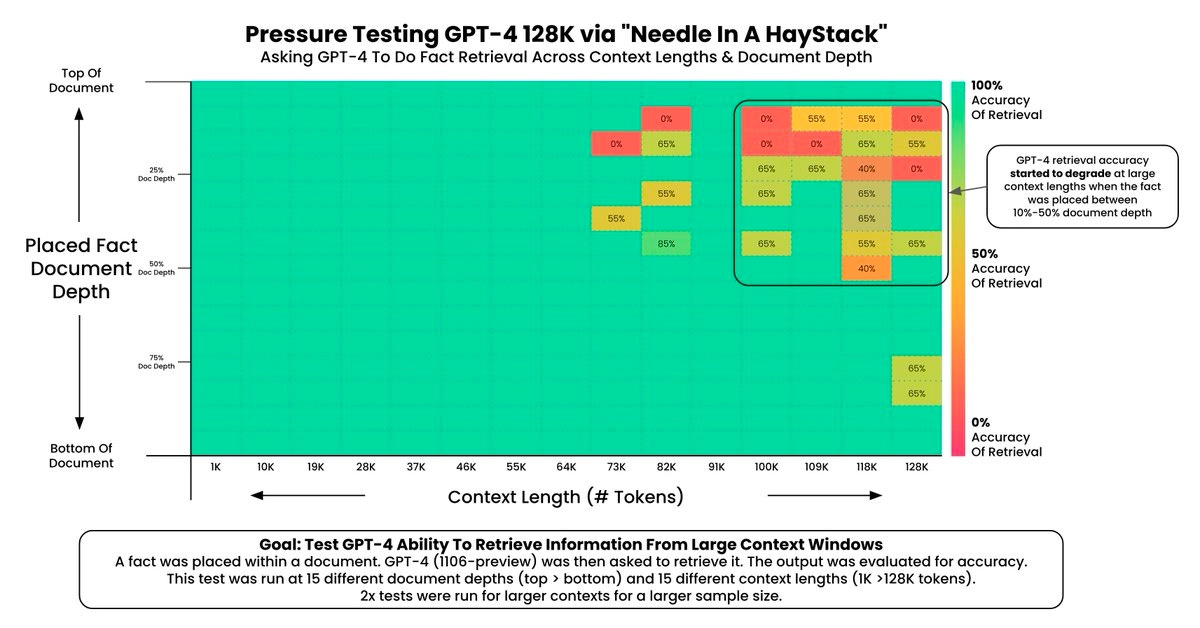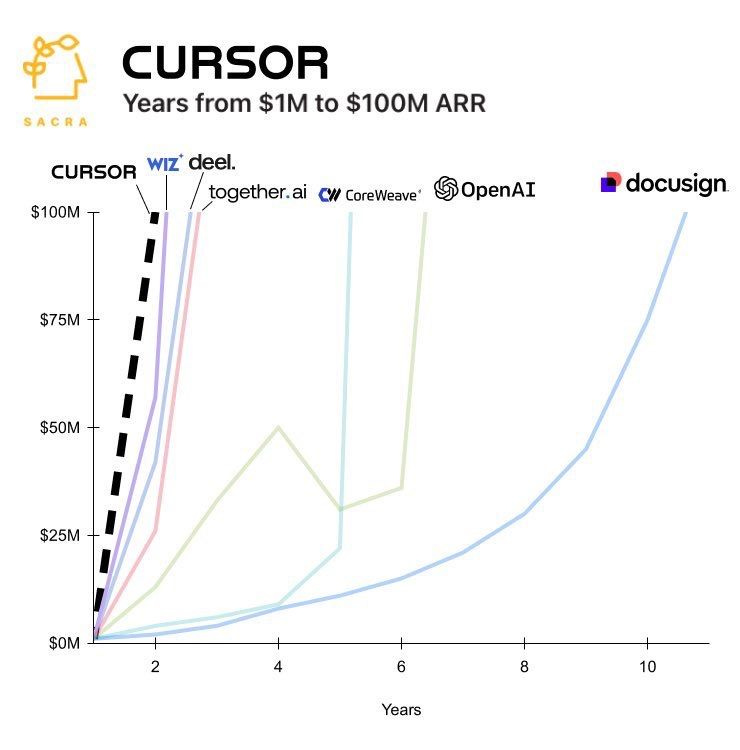Hey, friends! 👋
A very popular section of my newsletter has been my ‘Fantasy Fund Spotlight.’ I’d been looking for ways to make my newsletter more specific and tailored. Going forward Distrupt & Conquer is a newsletter about my investments from my imaginary $100M fund and every month I’ll be sharing the insights behind the decisions. I’ll be exploring their impact on the future of humanity and society through the lense of these emerging ventures and their founders.
I’ll continue to add links to any interesting thoughts from social media, books I’ve recently red and shoutouts but 80% of this newsletter will be a deep dive into one ‘investment’ per month.
Welcome to the fourth edition of my monthly newsletter, "Disrupt and Conquer"!
Benji
🚀 Fantasy Fund Spotlight: Anysphere Inc.
🌟 What's Anysphere?
Anysphere is the team behind Cursor, an AI powered Integrated Development Environment (IDE). Since launching about 3 years ago, Cursor’s taken the software development community by storm with a rapid rate of adoption amongst developers at OpenAI, Shopify, Instacart and more fast paced companies.
By the way, if you’re not familiar with what an IDE is. Think of an IDE as the "Microsoft Word" for software development it's where developers write, debug, and manage code for apps and websites.
🔍 Solving AI's "Context Problem" For Code
One of the biggest limitations of large language models (LLMs) like ChatGPT today is their "context window," essentially how much information they can digest at once—think of it as the AI's equivalent of their short term memory.
Google's latest Gemini 1.5 Pro model can handle an impressive 2 million tokens, roughly 700,000 words or over 30,000 lines of code. But even advanced models like Gemini struggle with accuracy when requests start hitting the top ceiling of their ‘context windows’.
The bigger the input, the lower the performance. For example, a retrieval test called "needle in a haystack" with GPT-4 showed a significant drop from 72% accuracy (32,000 tokens) down to just 38% (128,000 tokens).
That’s quite outdated now and Google’s model Gemini 1.5 Pro performs exceptionally when retrieving a single piece of information, (99.7%). However, its performance decreases significantly to 60% when tasked with finding multiple specific pieces of information within a 1 million token context.
The thing is, this is still a particularly relevant problem for coding scenarios, where developers typically need to accurately retrieve and reference multiple elements simultaneously from large codebases.
🛠️ Cursor's Approach to Complexity
Cursor isn't just feeding entire codebases into AI and done. Instead, it intricately breaks down codebases into logical parts ("chunks"), storing them using a technique called vectorisation.
For non technical people, it’s a kind of like a librarian who organises her library not just by book titles but also each book’s core ideas and themes.
Cursor basically identifies relationships across code chunks, providing developers with exactly the relevant information at precisely the right moment.
You can reference specific code chunks or pages to make your requests more accurate.
They’ve created streamlined workflows that reduce the load on these models, making them more accurate.
📊 Efficiency Gains
I couldn’t find any publicly available "needle in a haystack" benchmarks directly comparing Cursor to standalone models, but some of the Cursor community has started measuring the gains themselves. One developed noticed a:
✅ 73% reduction in time spent writing repetitive "boilerplate" code.
✅ 42% faster debugging, significantly outperforming competitors like GitHub Copilot (25%) and Gemini (18%).
✅ Saved 121 lines of code per hour, compared to GitHub Copilot's 82 lines.
Cursor has transformed me personally from a beginner to a confident builder, allowing me to develop multiple projects in mere weeks:
Just Debate: fantasy politics app.
Meal Prep Automation App: A smart kitchen assistant using AI vision and a Notion integration:
Snap recipe photos → AI identifies ingredients and steps → auto-sync shopping lists and meals.
Cursor has helped me navigate building structured objects, working with all sorts of integrations and APIs, building with Supabase, Firebase and deploying with Vercel. For me, it’s been the number one tool that’s accelerated my software development knowledge.
🖥️ Cursor Has Better 'Vibes'
Honestly above all else. Cursor simply has better ‘vibes’, which is really hard to measure.
But to me, it just has a superior coding experience, one that feels more enjoyable and efficient. It’s a bit like asking why many prefer an iPhone over Android, they choose an iPhone for its intuitive feel and user experience, developers are flocking to Cursor because it just feels better to use and so far most have seen anecdotal efficiency gains.
🏰 Cursor's Competitive Advantage & Potential Risks
Cursor is built upon Microsoft's open source IDE, Visual Studio Code. This was a double edged sword because it helped them spin up a product really quickly but it could potentially make their competitive advantage very fragile.
Given Microsoft's vast resources and their own competing product GitHub Copilot there's a valid concern that Microsoft could eventually close the gap.
But, despite this potential vulnerability, Microsoft still hasn’t managed to catch up over the past three years and Cursor could use it’s momentum to end up just running away with it.
GitHub CoPilot and ChatGPT assist developers mainly line by line a bit like interior designers helping with individual rooms. Cursor rather acts as a master architect. It thoughtfully considers your project's entire structure, context, and integrity.
And look, I’m sure that won’t be the case for long. But Cursor already has a ton of user interactions to know how to make their ‘architect’ approach better, they’ve recently become even more powerful with Cursor's introduction of "rules," they are like specialised files that guide Cursor within specific areas of your codebase.
If they can get some of these software developers as champions in big enterprises, they can lock in large enterprise contracts and stave off Microsoft’s counter attack for a few more years to come.
💸 Financial Snapshot: Rapid Growth & Valuation
Cursor has rapidly approached a crazy milestone nearly $100 million ARR (Annual Recurring Revenue) in three years. In December 2024, the company raised funding at an impressive valuation of $2.5 billion, representing actually quite a conservative multiple (~25x revenue) for AI.
For comparison, developer platform Vercel is valued at ~56x revenue and probably the somewhat modest valuation suggests there’s still some investor caution due to competition risks from Microsoft.
Update: Cursor is now in talks for another fundraising round of $10BN!
📅 Expanding Anysphere’s Ecosystem
Anysphere needs to keep up this momentum and the only way to fight off Microsoft is by building a more tightly integrated development ecosystem. Cursor is just one tool in their tool box. I’m imagining more Anysphere products to come about in the coming months that’ll tightly integrate with Cursor.
Full Stack Integration: Database management, cloud hosting, and automated DevOps workflows.
Personalised AI Models: Building custom AI models that continuously adapt to someone's individual coding style, making it increasingly less attractive to switch to alternatives.
Integrated Code Repositories: Creating a proprietary code repository system deeply integrated within the Cursor environment to compete with GitHub head on. I think this is a tricky one to build but I could envision a cool partnership with Hugging Face.
⚠️ Potential Industry Disruption
So if someone like me has been able to personally build products much quicker and better than before, Cursor could significantly disrupt various markets, potentially encroaching upon several different industries and opening up software development to a whole new group of people:
Workflow tools like Zapier (Honestly, I found it so much easier to set up workflows by directly writing code. It was faster, free, easier to integrate APIs, and more customisable.)
Low code tools like Webflow (Maybe there's still a place for design centric platforms, but Cursor reduces the need significantly and is also cheaper to self host!)
Software development agencies and technology integrators (Cursor empowers those who have domain knowledge to become builders themselves.)
While other platforms (such as Loveable.dev) excel at fast, smaller scale prototyping outside of development environments, Cursor has positioned itself for larger, more complex projects. Personally, I found that building with Cursor offered me greater control compared to a higher level abstracted tool like Loveable.
If Cursor achieves its dream, anyone even an 80 year old could build complex, reliable software without much technical know how (we’re probably some way off on this vision though).
🌐 IPO or Acquired By… Amazon?!
This is purely a gut feeling and I haven't really read anything confirming it. But Anysphere is raising a considerable amount of funding, and it doesn't seem intended for an IPO if it continues this domain of building just the Cursor IDE. My sense is that they're more likely positioning for an acquisition. They're hot on the heels of Microsoft, who have historically held a real monopoly in the software development market through GitHub and VS Code.
At the same time, Google faces threats in their traditional search market from newer players like Perplexity, indicating all of a sudden that some of these large monopolies are genuinely vulnerable.
My instinct tells me Amazon might swoop in and acquire Anysphere before they build out more tools.
AWS, Amazon's cloud service, already hosts Cursor's infrastructure and significantly invests in Anthropic—the leading AI model powering Cursor. This acquisition could neatly complement AWS's developer offerings. Google might also be a contender, but I feel like they're currently too distracted by the threat posed by Perplexity.
If no acquisition takes place, then Anysphere builds up their entire developer community tools that I pointed out earlier.
We’re talking databases, cloud hosting. That involves more than just software expertise, a build up of data centres and energy is needed, quite a big challenge ahead.
📈 Investment Summary
Let's be honest, I'd never even get close to participating in this deal. It's one of the most competitive investments in Silicon Valley right now, with top tier VCs fighting for allocation. While I do have some reservations about the valuation, the fundamental principle in venture capital remains: the bigger risk is missing out on a transformative company rather than losing money on an investment that doesn't work out.
There's a plausible future where Anysphere builds sufficient capabilities to genuinely compete with the Mag7 tech giants, because it has visibility into developer workflows, preferences and their projects being built. This kind of position and data advantage represents an opportunity that a ton of investors won’t want to miss.
Raised: $176 million (soon to be more)
Assumed Valuation: $2.5 billion (Dec 2024), (soon to be $10 billion)
ARR: > $100 million
Investment: $2 million
I’d try to hop onto one of the syndicates involved in the deal, provide a $2M cheque and be a silent investor.
Every month, I'll update this table so you can track my investments, and each year, we'll reassess to see if my stakes have changed.
This is a fantasy fund and does not account for liquidation preferences, voting rights, dilution clauses, or whether I'd even be accepted on the cap table. It's just for fun to see if any of my fantasy investments would pay off!
Book Recommendations
Scaling Lean
Algorithms We Live By
You’re About To Make A Terrible Mistake
Good Arguments
Congratulations to…
Congrats to Yousef and Sam on their recent £1M raise for Artanis!
Have a great week everyone.
I’ll be back in your inbox next month.
Thanks for reading
Benji








